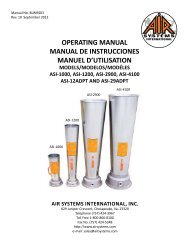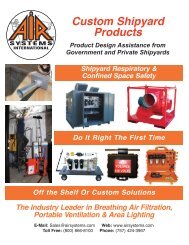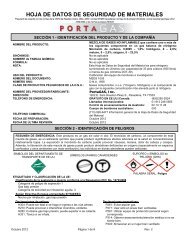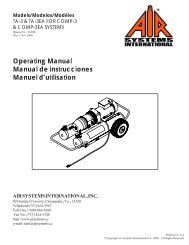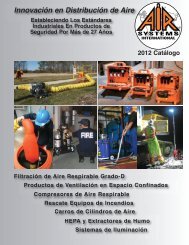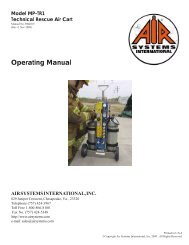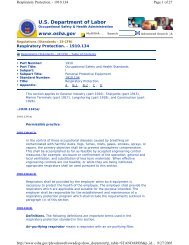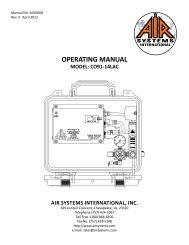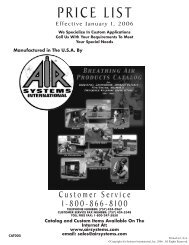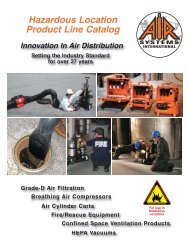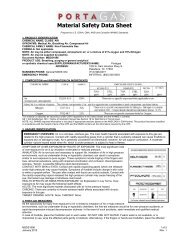(CGA) 7.1-1989 Air Grade Specifications Trace Analytics
(CGA) 7.1-1989 Air Grade Specifications Trace Analytics
(CGA) 7.1-1989 Air Grade Specifications Trace Analytics
Create successful ePaper yourself
Turn your PDF publications into a flip-book with our unique Google optimized e-Paper software.
AIR SPECIFICATIONS<br />
TECHNICAL BULLETIN NO. 9401A (rev. 01.99)<br />
<strong>Trace</strong> <strong>Analytics</strong>, Inc. © 1998<br />
<strong>Air</strong>Check✔Notes TM<br />
Commonly Used <strong>Air</strong> <strong>Specifications</strong> for SCBA or airline respirators<br />
LIMITING <strong>CGA</strong>, <strong>Grade</strong> NFPA NFPA TX Comm OSHA<br />
CHARACTERISTICS D (1997) 1500 (1997) 1404 (1996) (1992) 1910.134 (‘98)<br />
Percent O 2<br />
Balance atm/ atm/ atm/ atm/ atm/<br />
Predominantly N 2<br />
19.5 - 23.5 (5) 19.5 - 23.5 (5) 19.5 -23.5 (5) 19.5 -23.5 (5) 19.5 – 23.5 (5)<br />
Water, ppm (v/v) (3) (3)
COMPRESSED GAS ASSN, <strong>CGA</strong> G-<strong>7.1</strong>–1997, Commodity Specification for <strong>Air</strong><br />
(Page 3) Table 2 describes typical users and appropriate air quality grade levels. It lists Gr A for industrial<br />
compressed air (non-breathing air but inappropriate for instrument air since it does not limit condensed<br />
hydrocarbons (oil)), Gr L for SCBA air (does not include complete requirements for safe air), Gr D for OSHA<br />
breathing air, Gr E for SCUBA, Gr J for specialty grade air, analytical applications, and N for Medical/USP air<br />
(some of the Gr J & N limiting characteristics can only be met by synthesized air.) (Page 2) Table 1 has<br />
dropped <strong>Grade</strong>s K, G, and M. Gr L only requires testing of dew point/water, odor, and oxygen. The limit<br />
(which is also referenced as Note 3 has been changed to the stricter -65°F/24ppm (same as NFPA 1500) or<br />
10°F lower than the coldest expected temperature. For fire department use, the appropriate requirements<br />
are Gr D with Note 3 requirements for moisture. Fire departments who have Underwater Rescue Teams<br />
frequently specify compliance with Gr D and Gr E. In the ‘97 revision, Gr E carbon dioxide limits have been<br />
raised from 500 ppm to 1000 ppm. Gr E includes an additional limit for total hydrocarbon content (as methane)<br />
to 25 ppm and specifies 20-22% oxygen. The standard still does not address sampling frequency for<br />
users who have their own air compressor. For users who purchase air from vendors (typically who synthesize<br />
air by blending oxygen and nitrogen) there are several quality verification systems that may be used which<br />
can best be summed up by stating that whatever is agreed upon between the supplier and the customer is<br />
acceptable. (Page 1, Sec. 3.1) Production qualification tests may be performed by the supplier or by a laboratory<br />
agreed upon between the supplier and the customer.<br />
NATIONAL FIRE PROTECTION ASSOCIATION, NFPA 1500, 1997 Edition<br />
(Sec. 5-3.1) A fire dept. is to adopt and maintain a respiratory protection program that includes the assurance<br />
of air quality testing. (Sec. 5-3.1.1) The respiratory protection program shall meet the requirements of NFPA<br />
1404 which includes among other things the use of an accredited laboratory. (Sec. 5-3.2) Dept. will have<br />
written standard operating procedures (SOP). (Sec. 5-3.6) A minimum air quality of ANSI/<strong>CGA</strong> G-<strong>7.1</strong>, <strong>Grade</strong><br />
D, a dew point level of -65°F (24 ppm) or dryer, and a maximum particulate level of 5 mg/m 3 . (Sec. 5-3.7)<br />
WHEN AIR IS PURCHASED IN A VENDOR SUPPLIED SCBA CYLINDER, the fire dept. shall require the<br />
vendor to provide documentation that a sample of air obtained directly at the point of transfer from the<br />
vendor’s filling system to the SCBA has been tested at least quarterly and meets <strong>Grade</strong> D as stated in Sec.<br />
5-3.6. (Sec. 5-3.<strong>7.1</strong>) WHEN THE FIRE DEPT. MANUFACTURERS ITS OWN BREATHING AIR, the dept.<br />
shall be required to provide documentation that a sample of the breathing air obtained directly from the point<br />
of transfer from the filling system to the SCBA cylinders has been tested at least quarterly as stated in Sec. 5-<br />
3.6.<br />
NATIONAL FIRE PROTECTION ASSOCIATION, NFPA 1404, 1996 Edition<br />
(Sec. 7-1.1) <strong>Air</strong> for SCBA taken from production of compressor and storage system shall meet the testing<br />
and quality requirements of <strong>CGA</strong> G–<strong>7.1</strong> with a minimum quality of <strong>Grade</strong> D and a maximum dewpoint level of<br />
-50°F (63 ppm) or 10°F lower than the coldest temperature expected in the area( refers to <strong>1989</strong> version)<br />
(Sec. 7-1.2) IF AIR IS PURCHASED IN A VENDOR SUPPLIED CYLINDER, the fire dept. will require the<br />
vendor to provide certification and documentation that air has been tested by an accredited laboratory and<br />
meets <strong>Grade</strong> D requirements as stated earlier. IF FIRE DEPT. MAKES ITS OWN BREATHING AIR OR<br />
TRANSFERS PURCHASED AIR FROM VENDOR CYLINDERS into other storage cylinders, dept. shall test<br />
at least quarterly by accredited laboratory. (Sec. 7-1.3) Maintain records for each air quality test. If air does<br />
not meet <strong>Grade</strong> D requirements, use of system shall be discontinued until repairs are made and verified by<br />
air quality tests. (Sec. 7-1.4) ANY AIR CYLINDERS CONTAINING AIR SUSPECTED OF NOT MEETING<br />
AIR STANDARDS SHALL BE EMPTIED AND PURGED.<br />
TEXAS COMMISSION ON FIRE PROTECTION, (Fire Fighter Safety, Chapter 435) applies to any Texas<br />
fire dept. who has at least 1 paid person. (4) Ensure that compressed breathing air from any source, including<br />
but not limited to transferred air from vendor cylinders to other cylinders, fire dept. air compressors, cascade<br />
systems and private sources, that is used to fill the cylinders of a SCBA complies with the minimum standards<br />
of the National Fire Protection Association for air quality testing of compressed breathing air and<br />
identified in NFPA 1500, 1992 edition. (5) Ensure that at least every six months, samples of the air used to fill<br />
<strong>Trace</strong> <strong>Analytics</strong>, Inc. • 15768 Hamilton Pool Rd. • 800-247-1024 • 512-263-0000 • Fax 512-263-0002 2 of 4
the cylinders of SCBA are tested by a testing laboratory which currently holds accreditation to test breathing<br />
air from a nationally recognized accrediting organization. <strong>Air</strong> samples shall be taken directly from the point<br />
where SCBA cylinders are connected for filling. If a fill station has more than one port where a SCBA cylinder<br />
can be attached and if only one sample is taken from the fill station, then the sample shall be taken from the<br />
port that ensures that all components of the fill station are tested. It is “recommended” that the air used to fill<br />
cylinders of SCBA be tested at least every 3 months.<br />
OSHA, 1910.134, Respiratory Protection, revised 1/8/98, effective 4/8/98,<br />
Section (c) Respiratory protection program, requires the employer to develop and implement a written<br />
respiratory protection program with required work site-specific procedures and elements for required respirator<br />
use. (c)(vi) Among other things, the plan should include procedures to ensure adequate air quality, quantity,<br />
and flow of breathing air for atmosphere-supplying respirators. A sample program is available from<br />
OSHA’s Office of Publications, ask for “Small Entity Compliance Guide.” For a copy, call 202-693-1888.<br />
Section (i) Breathing air quality and use (1)(ii) mandates compliance with Type 1-<strong>Grade</strong> D breathing air<br />
described in ANSI/Compressed Gas Assn. Commodity Specification for <strong>Air</strong>, G–<strong>7.1</strong>–<strong>1989</strong>. (Section i (4)) (i)<br />
CYLINDERS used to supply breathing air to respirators are tested and maintained according to DOT (49 CFR<br />
part 173 & part 178). (i)(4)(ii) CYLINDERS of purchased breathing air must have a certificate of analysis from<br />
the supplier that air meets <strong>Grade</strong> D specifications. (i)(4)(iii) The moisture content in the CYLINDER does not<br />
exceed a dew point of -50°F at 1 atmosphere pressure. (i)(5) The employer shall ensure that COMPRES-<br />
SORS used to supply breathing air to respirators are constructed and situated so as to: (i)(5)(i) prevent entry<br />
of contaminated air into the air supply system (i)(5)(ii) Minimize moisture content so that the dew point at 1<br />
atmosphere pressure is 10°F below the ambient temperature. This is intended for airline respirator use not for<br />
high pressure filling of SCBA’s. (i)(5)(iii) Have suitable in-line air-purifying sorbent beds and filters to further<br />
ensure breathing air quality. Sorbent beds & filters shall be maintained and replaced/refurbished according to<br />
manufacturer’s instructions. (i)(5)(iv) Have a tag on the compressor containing the most recent change date<br />
and the signature of the person authorized by the employer to perform the change. (i)(6) For compressors<br />
that are not oil-lubricated, ensure that carbon monoxide levels in the breathing air do not exceed 10 ppm.<br />
(i)(7) For oil-lubricated compressors, use a high-temperature or carbon monoxide alarm or both. If only a<br />
high-temperature alarm used, monitor sufficiently to prevent carbon monoxide from exceeding 10 ppm. (i)(8)<br />
Breathing air couplings are incompatible with outlets for nonrespirable work site air or other gas systems.<br />
NOTE: The new OSHA revision references the <strong>1989</strong> version of <strong>CGA</strong> air specifications. The <strong>CGA</strong> standard<br />
was revised in 1997; however not published and released until May of 1998. In the past whenever <strong>CGA</strong> has<br />
updated this standard, OSHA Directorate of Compliance Programs has issued letters of interpretation that<br />
required employers to use the updated air specifications.<br />
OSHA, 1910.156, Fire Brigades, same as OSHA 1910.134.<br />
OSHA, 1910.430, Commercial Diving, has not been updated recently. Mandates that air shall not contain<br />
levels greater than 20 ppm of carbon monoxide (Note: precedence is to use current <strong>CGA</strong> standard see Note<br />
above), 1000 ppm of carbon dioxide, 5 mg/m 3 of oil mist, a noxious or pronounced odor, and semi-annual<br />
testing.<br />
ANDI (American Nitrox Divers International) requires compliance to a modified <strong>Grade</strong> E shown in chart &<br />
quarterly testing.<br />
IANTD (International Association of Nitrox & Technical Divers, Inc.) requires compliance to a modified <strong>Grade</strong><br />
E shown in chart.<br />
NAUI (National Association of Underwater Instructors) Code of Ethics commitment to quarterly testing according<br />
to modified E or <strong>Grade</strong> E (as appropriate).<br />
PADI (Professional Association of Diving Instructors) requires compliance to <strong>Grade</strong> E, 1997 and quarterly<br />
testing.<br />
UBS-DNAX (Undersea Breathing Systems, Inc.) requires quarterly testing and compliance with <strong>Grade</strong> E and<br />
modified <strong>Grade</strong> E as shown above.<br />
For a complete copy of the <strong>CGA</strong> specifications, contact the <strong>CGA</strong> at 1725 Jefferson Davis Highway, Suite 1004, Arlington, VA 22202,<br />
703-412-0900. The OSHA Federal Register, 29 CFR PARTS 1910 and 1926, Respiratory Protection can be obtained free of charge<br />
on the internet at www.osha.gov. Copies of NFPA 1404 and 1500 are available for purchase from the National Fire Protection<br />
Association at 1 Batterymarch Park, PO Box 9101, Quincy, MA 02269-9101, Order Desk Phone 800-344-3555. The Texas Commission<br />
on Fire Protection can be reached at PO Box 2286, Austin, TX 78768-2286, 512-918-7100.<br />
<strong>Trace</strong> <strong>Analytics</strong>, Inc. • 15768 Hamilton Pool Rd. • 800-247-1024 • 512-263-0000 • Fax 512-263-0002 3 of 4
Information on Oxygen Enriched <strong>Air</strong> Analyses<br />
We receive frequent requests for <strong>CGA</strong> <strong>Grade</strong> J analyses. Refer to the <strong>Air</strong> <strong>Specifications</strong> on the reverse side<br />
for a complete list of testing specifications. Typical use for <strong>Grade</strong> J air is listed by the Compressed Gas<br />
Association as Specialty <strong>Grade</strong> <strong>Air</strong> and Analytical Applications. It does not list it for oxygen enriched air for<br />
diving nor was it intended for that purpose. It is a physical impossibility for a dive shop using an air<br />
compressor to meet the carbon dioxide levels of 0.5 ppm. <strong>Grade</strong> J also does not have a limit for<br />
condensed hydrocarbons (oil) which is of extreme concern for those producing oxygen enriched air.<br />
<strong>Grade</strong> J is an expensive analysis that is not applicable for use without severe modifications. Organizations<br />
such as American Nitrox Divers International (ANDI) and International Association of Nitrox & Technical<br />
Divers, Inc. (IANTD) modified the <strong>CGA</strong> <strong>Grade</strong> E specification for use with oxygen enriched air. <strong>Trace</strong> currently<br />
provides analyses according to these two different specifications. If you require a different specification,<br />
please fax the requirements and we will be glad to provide a price quote.<br />
Oxygen Compatible I (same as IANTD) is a modification of <strong>CGA</strong> <strong>Grade</strong> E requirements which reduces the<br />
levels of carbon monoxide to 2 ppm and condensed hydrocarbons to .1 mg/m 3 . Other analytes remain the<br />
same as stated in <strong>CGA</strong> <strong>Grade</strong> E. If you are taking 1 sample for certification of both your <strong>Grade</strong> E and Oxygen<br />
Compatible air, there is no additional cost. If you are submitting two separate samples; one for <strong>Grade</strong> E and<br />
and one for an Oxygen Compatible system, the cost will be for two samples at your routine price.<br />
Oxygen Compatible A (same as ANDI) is a modification of <strong>CGA</strong> <strong>Grade</strong> E requirements which reduces the<br />
levels of carbon monoxide to 2 ppm and condensed hydrocarbons to .1 mg/m 3 . It also requires moisture<br />
analysis at




